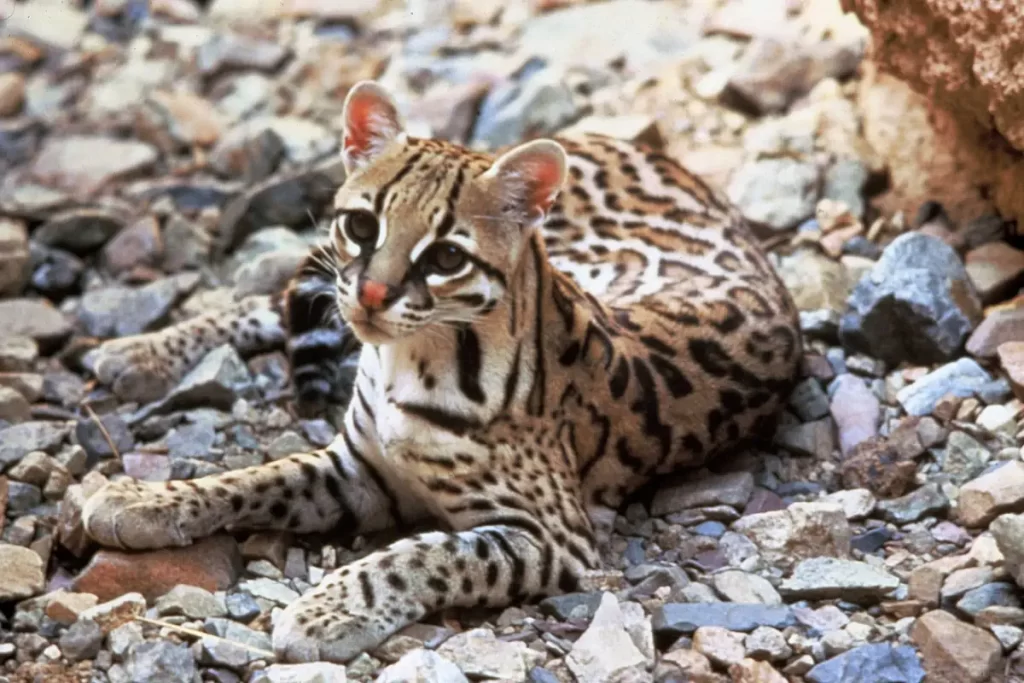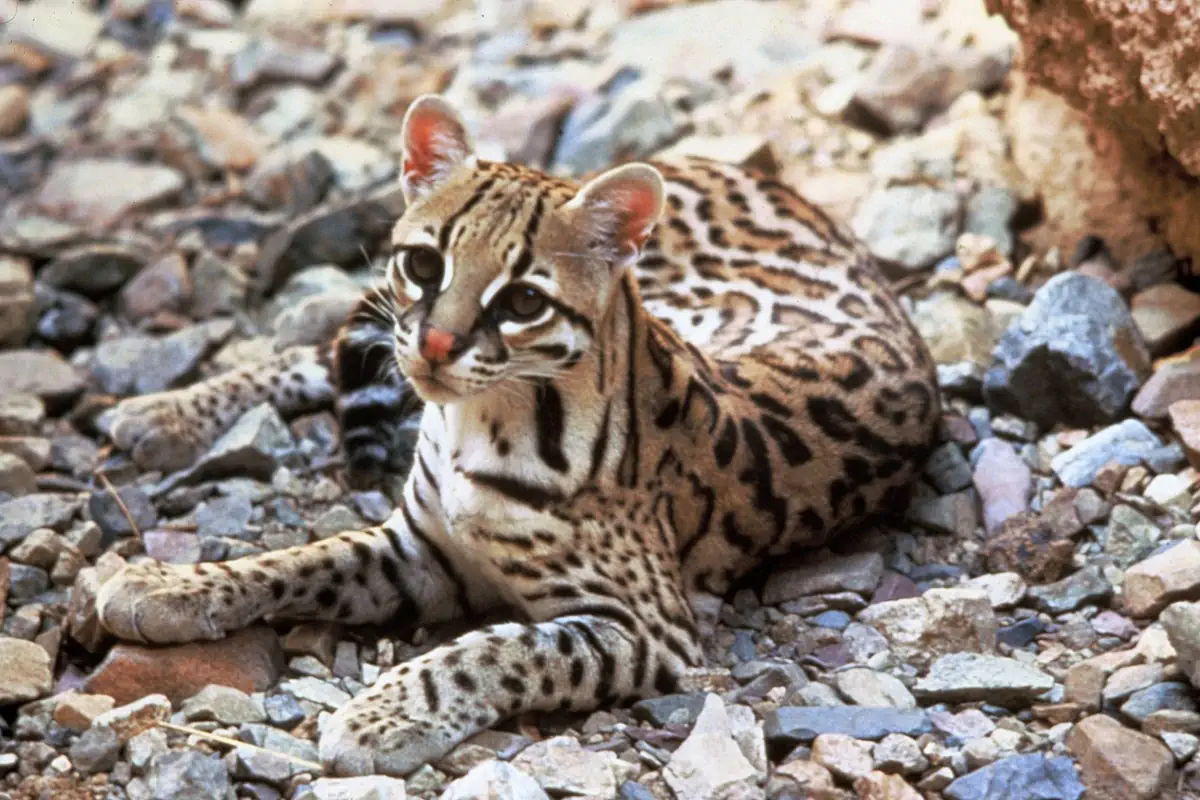Ocelot (scientific name: Leopardus pardalis) is a medium-sized spotted wild cat. It is about twice the size of a typical housecat. The Ocelot is native to Mexico, Central and South America, the southwestern United States, and to the Caribbean islands of Trinidad and Margarita. They occupy tropical forests, mangrove forests, savanna grasslands, coastal swamps, and thorny plains.
Ocelot is also known as the dwarf leopard because of its unique color patterns. Here are 10 amazing ocelot facts.
Ocelot facts
1. Each ocelot has a unique color pattern
Ocelots can be identified by the pattern on their spotted coat. Every ocelot’s color pattern is unique, much like the human fingerprint.
They have clear, dark-toned distinctive colors and deep black spots. Often there are color markings located parallel to the sides of the body.

Image: Close view of an ocelot. By Tom Smylie – US Fish & Wildlife Service Image Archive, Public Domain, Link
2. They are larger than common housecats
The ocelot is twice as large as the regular housecat. They can grow to around 29 to 39 inches (73 to 100 centimeters). Females are slightly smaller. Males weigh 15 to 34 lbs. (7 to 15.5 kg) and females weigh 14.5 to 25 lbs (6.6 to 11.3 kg).
3. They like water
Unlike most other cats, ocelots are good swimmers (like tigers).
Video: a male ocelot goes for a swim.
4. Ocelot are hypercarnivores
Like other cats, ocelots are hypercarnivores, meaning they have a diet that is more than 70% meat.
They are also nocturnal (they mostly active during the night). These animals all go hunting at night.
Ocelots have excellent vision (adapted to night vision) and hearing, which are used in detecting prey.
They feed on small rodents, reptiles, birds, medium-sized mammals, crustaceans, and fish. Most of their prey are mice, rats, opossums, and armadillo species.
Ocelots also have sharp teeth for tearing apart prey, but they do not have teeth for chewing, so they swallow pieces of food without chewing and ocelots have a tongue that successfully separates even small pieces of meat from bones.
5. The name “ocelot” comes from an Aztec word
The name “ocelot” comes from the Aztec word ōcēlōtl, which generally refers to the jaguar, rather than the ocelot.
There’s a historic association of the ocelot with humans. The Moche people of ancient Peru worshiped animals, often painting ocelots in their art.
The Aztecs, along with many other indigenous cultures of the region, honored this wild cat and revered it for its hunting prowess and beauty.
6. They can mate any time during the year
After mating, females find a hollow tree, dense thorn bush, or crack in the rock in preparation for birth.
Pregnancy lasts up to 85 days and ends with 2 to 3 kittens.
When the kittens are a few months old, they begin to learn how to hunt from their mothers. Males become sexually mature at 15 months and females at 18 to 22 months.
7. Their lifespan is short
In the wild, their lifespan is only 7-10 years. But, like many other wild animals, they tend to live longer in captivity. If well cared for, they can live up to 20 years.
8. They have retractable claws
Like other cat species (with the exception of cheetah) ocelots have retractable claws.
9. Aztec and Incan people have occasionally kept ocelots as a pet
Today, it’s widely accepted that keeping wild animals as a pet is not a good thing, both for the animal itself and for the people who keep it as a pet.
According to the Big Cat Rescue, 21 out of 50 U.S. states ban all dangerous exotic pets, including ocelots.
In Connecticut, Idaho, Illinois, and Missouri, the ocelot is specifically named in the banned wild animals to be kept as pets.
10. Salvador Dalí’s ocelot
Spanish painter Salvador Dalí, a cat lover, got his favorite pet cat, an ocelot named Babou, in the 1960s and took him everywhere with him.
He was claimed to have gotten the cat from a Colombian President.

Conversation status of Ocelots
The global population size of the ocelot has not been quantified. Certain regions have numerical estimates of this species: 40,000 mature ocelots in Brazil, 1,500 to 8,000 ocelots in Argentina, and 50 to 80 ocelots in Texas.
In general, ocelots are classified as Least Concern on the threatened species list, but, unfortunately, their numbers are rapidly declining today.
The ocelot is threatened by the loss and fragmentation of their habitat. In the1970s and 1980s, they were hunted for their skin and fur. The illegal international pet trade is another threat.
Sources
- Ocelot on Wikipedia
- Sloth Facts: 10 Amazing things about these adorable mammals - August 12, 2022
- 10 Amazing Koala Facts - February 18, 2022
- 10 Amazing Humpback Whale Facts - December 22, 2021
